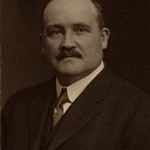Haviland mustache cup, 2000.02.09
Out of all the china/dishware found in the Library’s collections there is only a single example of a mustache cup. One is immediately tempted to think, ah yes, this was used by one of Mary Baker Eddy’s household staff with a mustache, perhaps her longtime secretary Calvin Frye, or perhaps Adam Dickey or William Rathvon—maybe Irving Tomlinson. No? How about …
A look at the catalogue record indicates that the cup and saucer belonged to none other than George W. Glover, Eddy’s son.
Why is this surprising? Because Glover, Eddy’s only biological son, was a Westerner, having been separated from his mother at the age of seven and placed with a couple who later moved out to Minnesota. (See Gillian Gill’s biography, Mary Baker Eddy, chapters 5 and 6 for more information on Eddy’s son.) Glover never received the kind of upbringing nor education that Eddy would have given him. In a fragment, possibly part of a draft for her book Retrospection and Introspection, Eddy dictated to her secretary, Calvin Frye, “The family to whom he went moved to the far West & which deprived me of the early education of my son that I have always considered my severest calamity.”1
Instead, Glover worked as a farmhand, joined the Union Army, homesteaded in Fargo, ND, had a freighting business in Deadwood, SD and mined gold in the neighboring town of Lead (pronounced Leed)—the land of Wild Bill Hickok and Calamity Jane.
During an extended visit to Boston in 1887 Glover was described by a young girl as having a loud voice, boisterous manner and unusual “costume.” He wore high boots with his pants tucked into them and his hair was long with a beard.2
Wearing a mustache was very popular during the Victorian and Edwardian eras (1837-1910). In fact it was practically required for certain military ranks and social positions. A proper mustache required a fair amount of attention, and to assist with its maintenance there was an assortment of products and tools available in the forms of mustache wax, mustache combs, mustache brushes, and mustache curlers.
The mustache cup was invented in the 1860s by Harvey Adams, an English potter. Adams added an extra piece of clay that formed an arch or bridge near the rim of the cup. This additional piece acted as a guard for the mustache, allowing the user to drink from the cup while preventing the mustache from coming in contact with the liquid. Thus the cup prevented mustache wax melting into the beverage or the liquid from staining the mustache, not to mention a soggy mustache. However, with the addition of the guard to the cup it caused the cup to become specifically a right-handed or a left-handed cup.
George’s mustache cup was a gift from his daughter, Mary Baker Glover Billings. We have no record as to the date of the gift. However, based on the design and markings it was 1894 or later. The cup is white porcelain china with the “Clover Leaf” pattern around the edge and a gold painted rim. Both the mustache guard and handle of the cup are also painted gold. It was manufactured by Haviland and Co., Limoges, France.







